
Sheer Heart Attack is the third studio album by the British rock band Queen, released on 8 November 1974 by EMI Records in the United Kingdom and by Elektra Records in the United States. Digressing from the progressive themes featured on their first two albums, the album featured more pop-centric and conventional rock tracks and marked a step towards the "classic" Queen sound. It was produced by the band and Roy Thomas Baker, and launched Queen to mainstream popularity in the UK and throughout the world.

A Night at the Opera is the fourth studio album by the British rock band Queen, released on 21 November 1975 by EMI Records in the United Kingdom and Elektra Records in the United States. Produced by Roy Thomas Baker and Queen, it was reportedly the most expensive album ever recorded at the time of its release.
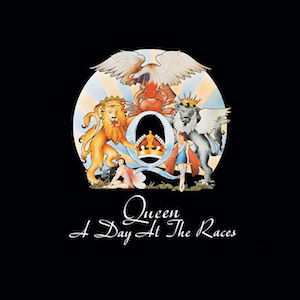
A Day at the Races is the fifth studio album by the British rock band Queen, released on 10 December 1976 by EMI Records in the United Kingdom and by Elektra Records in the United States. Recorded at The Manor, Sarm East, and Wessex Sound Studios in England, it was the band's first completely self-produced album, and the first completed without the involvement of producer Roy Thomas Baker; engineering duties were handled by Mike Stone. It serves as a companion to Queen's previous album, A Night at the Opera, with both taking their names from Marx Brothers films and having similar packaging and eclectic musical themes.
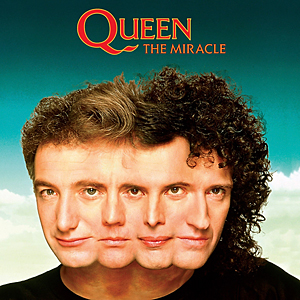
The Miracle is the thirteenth studio album by the British rock band Queen, released on 22 May 1989 by Parlophone Records and Capitol Records in both the United Kingdom and the U.S. respectively, where it was the band's only studio album to be released on latter label. The album was recorded as the band recovered from Brian May's marital problems and Freddie Mercury's HIV diagnosis in 1987. Recording started in January 1988 and lasted for an entire year. The album was originally going to be called The Invisible Men, but three weeks before the release, according to Roger Taylor, they changed the name to The Miracle. It was also the last Queen album with a photo of the band on the front cover.

Hot Space is the tenth studio album by the British rock band Queen. It was released on 4 May 1982 by EMI Records in the United Kingdom and by Elektra Records in the United States. Marking a notable shift in direction from their earlier work, they employed many elements of disco, funk, R&B, dance, pop and new wave music on the album. This made the album less popular with fans who preferred the traditional rock style they had come to associate with the band. Queen's decision to record a dance-oriented album germinated with the massive success of their 1980 hit "Another One Bites the Dust" in the US.

"I Was Born to Love You" is a 1985 song by Freddie Mercury that was released as a single from his first solo album, Mr. Bad Guy. After Mercury's death, Queen re-worked this song for their album Made in Heaven in 1995, by having the other members play their instrumental parts over the original track, transforming the song from disco to rock. The Queen version from the Made in Heaven album also includes snippets of Mercury's ad-lib vocals taken from "A Kind of Magic" and from "Living on My Own".

"Killer Queen" is a song by the British rock band Queen. It was written by lead singer Freddie Mercury and recorded for their third album Sheer Heart Attack in 1974. It reached number two in the UK Singles Chart and became their first US hit, reaching number twelve on the Billboard Hot 100. The song is about a high-class call girl and has been characterised as "Mercury's piano-led paean to a Moët-quaffing courtesan".
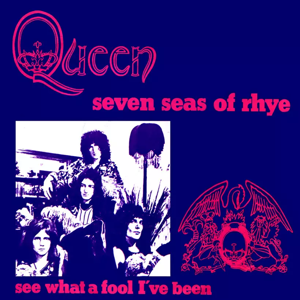
"Seven Seas of Rhye" is a song by the British rock band Queen. It was primarily written by Freddie Mercury, with Brian May contributing the second middle-eight. The song is officially credited to Mercury only. A rudimentary instrumental version appears as the final track on the group's self-titled debut album (1973), with the final version on the follow-up Queen II (1974).
"Love of My Life" is a song by the British rock band Queen from their 1975 album A Night at the Opera. The song is a sentimental ballad, notably featuring a harp played by Brian May.

"'39" is a song by British rock band Queen. Composed by lead guitarist Brian May, it is the fifth track on their fourth studio album A Night at the Opera. The song was also the B-side to "You're My Best Friend".
"No-One But You " is the final single recorded by the British rock band Queen. Recorded and released in 1997, six years after the death of lead singer Freddie Mercury, it is the only Queen recording to feature a three-piece lineup: guitarist Brian May, drummer Roger Taylor, and bassist John Deacon. May and Taylor share lead vocals. The song was released on the album Queen Rocks and it was also released as a double a-side single with "Tie Your Mother Down". It was later included on the compilation album Greatest Hits III.

"Spread Your Wings" is a power ballad by the rock band Queen, from their 1977 album News of the World. Written by bassist John Deacon, it was released as the A-side of the single "Spread Your Wings"/"Sheer Heart Attack" in 1978. According to music writer Benoit Clerc, "Spread Your Wings" was chosen as the 2nd single from News of the World because the band regretted releasing "Tie Your Mother Down" as a single from A Day at the Races over Deacon's "You and I."

"Las Palabras de Amor (The Words of Love)" is a rock ballad by the British rock band Queen. It was released as the third single from their 1982 album Hot Space. It is sung mostly in English, but with several Spanish phrases. Written by guitarist Brian May, the song proved more popular in the United Kingdom than their previous single ("Body Language"), reaching No. 17 in the UK Singles Chart.

"The Invisible Man" is a song by the British rock band Queen, written by drummer Roger Taylor but credited to Queen. The song is sung mostly by Freddie Mercury, with vocal contributions from Taylor. The song was released in August 1989 as the third single from the bands album The Miracle. Taylor claims that he got the inspiration to create the song while reading a book, and the bassline instantly came to his imagination. The song title was inspired by the H. G. Wells novel of the same name.

"The Miracle" is the fifth and final single from Queen's 1989 studio album of the same name. It was composed by the entire band, though Freddie Mercury and John Deacon were the main writers. It was released as a single on 27 November 1989 and it was the band's final single release of the 1980s.

"A Winter's Tale" is a song by Queen, from the album Made in Heaven, released in 1995 after Freddie Mercury's death in 1991. It was written after the Innuendo sessions, inspired as Mercury was staring out the windows of various places in Montreux. The song has a psychedelic, dreamy feel, and describes what Mercury saw outside the windows.

"Let Me Live" is a 1996 song by Queen, from the album Made in Heaven. Freddie Mercury, Roger Taylor and Brian May share lead vocals, with Mercury singing the first verse, Taylor singing the second verse and bridge, and May singing the last verse. During the choruses, all of the band members sing, as well as a background choir, giving it a gospel sound reminiscent of the band's 1976 single "Somebody to Love". The single reached No. 9 in the UK Single Charts, becoming the band's last Top 10 hit in that country.

John Richard Deacon is an English retired musician best known for being the bass guitarist for the rock band Queen. He wrote several songs for the group, including Top 10 hits "You're My Best Friend", "Another One Bites the Dust" and "I Want to Break Free"; co-wrote "Under Pressure", "Friends Will Be Friends" and "One Vision"; and he was involved in the band's financial management.
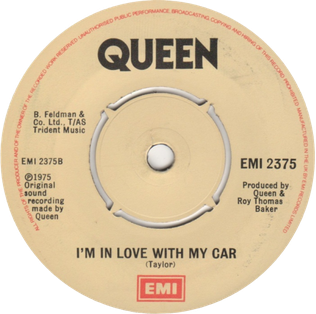
"I'm in Love with My Car" is a song by the British rock band Queen, released on their fourth album A Night at the Opera in 1975. It is the album's only song written entirely by drummer Roger Taylor.
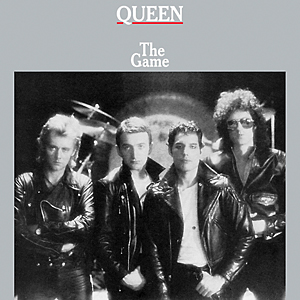
The Game is the eighth studio album by the British rock band Queen. It was released on 30 June 1980 by EMI Records in the UK and by Elektra Records in the US. The Game features a different sound from its predecessor, Jazz (1978). The Game was the first Queen album to use a synthesizer.


















